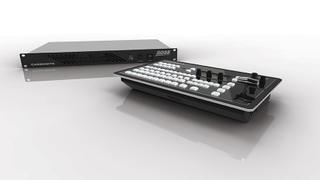NAB 2016: Ross Rolls Out a Camera

ROSS VEGAS— Ross Video is in the camera game. Ross introduced the new Acid camera system at its NAB presser Sunday. New versions of the Carbonite switchers and the XPression graphics platform were rolled out, as well as new IP features for the Acuity production switcher and vendor collaborations.
Par usual, Ross Video CEO David Ross launched the presser with the Ross financial summary. He said Ross marked 24 years of consecutive growth at the close of 2015.
“Average growth is getting to be higher than 17 percent… it was 21 percent last year,” he said. “It was all internally financed growth…. We are up 24 percent year-to-date so far in 2016.”
Acid was the big news. The new Acid camera, along with a stand-alone chroma key, were designed with the virtual green screen environments in mind.
Acid cameras include a new signal format developed by Ross to overcome the difficulties of creating decent chroma keys. These cameras output standard SMPTE 4:2:2 video signals as well as a special 0:4:4 full bandwidth color signal combined with the primary output within the new Carbonite UltrachromeHR system to generate a full resolution 4:4:4 signal. The Acid H200 has the highest resolution and performance specification of any 1080P camera system from any manufacturer.
Ross said Acid Z50 is a “moderately priced performer for slightly less demanding applications,” that fits mid range production systems and teams up with Ross camera robotics.
Acid follows the Ross line in its use of DashBoard control. All camera operation, setup and shading can be performed from DashBoard panels, including the transfer and recall of scene files from one ACID camera to another.
The companion Carbonite UltrachromeHR multichannel chroma key processor, based on the Carbonite, incorporates features that permit the automatic generation of solid key composition with little or no operator intervention. It takes HD-SDI inputs, and can output a second signal that contains full resolution chroma information not available in standard 4:2:2 signals.

The new Carbonites include Black Plus and Black Solo. The 36 inputs of Carbonite Black Plus come equipped with frame synchronizers, format converters, color correction and proc amps, with the same features on 12 of its 25 outputs.
The new Black Plus processing engine powers five multiviewers with up to 16 configurable windows each. This provides 80 windows in total. All 36 inputs, 22 outputs, the media stores, three MEs and four MiniMEs and aux buses can be monitored. The processing engine includes three new outputs dedicated to MultiViewers, so that main outputs aren’t sacrificed for monitoring.
Also, all 16-input Carbonite models now get two more inputs for free. As of NAB, any Carbonite systems ordered with 16 inputs will now be shipped with 18 active inputs and existing Carbonite customers will have these extra two inputs unlocked with version 12 software. XPression Live CG software also comes with every Carbonite production switcher.
Carbonite Black Solo is a compact switcher with nine inputs and six outputs, designed for smaller productions. On the input side, Solo has six SD/HD-SDI connections and three HDMI inputs, and there are six floating

frame synchronizers with format converters that can be assigned to any input. For outputs, there are five SDI and one HDMI, all assignable.
Solo will come in three versions. The first is an all-in-one control panel and electronic processing. The second is a rack-mount electronic frame with soft control panel. The third comprises a control panel plus separate electronic frame is for installations where it is desirable to separate operation from electronics.
XPression Tessera is a multi-display real-time graphics designer and controller for sport venues and studio video walls. Tessera enables users to link together multiple XPression engines to create a scalable matrix of channels for seamless output of scenes across large or irregularly assembled display panels. Perfect for sports scoreboards, ribbon boards, and studio video walls, Tessera’s resolution can scale by adding more XPression engines or “Tessera nodes.”
Acuity is now using vers. 4 software. Version 4.0 expands the capabilities of the multifeed functionality with added split ME controls. It is possible to set up an Acuity ME as two MEs with up to eight keyer assignments. A fully loaded eight ME machine can now be configured as a massive 16 ME system, or a full four ME UHD (4K) switcher. New warp effects and lighting engines are also included.
In a collaborative effort with Evertz, Acuity can now be equipped with IP (10Gb) I/O signal management. The new Acuity IPBlades work with ASPEN and SMPTE 2022-6 protocols and also provide standard SDI connections. These new IP I/O cards can coexist with standard Acuity I/O cards permitting hybrid IP/SDI system configurations.
On the show floor, IP interconnect with Acuity will be demonstrated in the ASPEN Community booth, the Evertz booth, and the Ross booth; all with IP signal management under control of the Evertz Magnum control system.
Ross also announced collaborations with Grass Valley and Hitachi. Ross and Grass are teaming up to integrate the Grass Valley Stratus production and management system into the Ross Inception News editorial system.
The Hitachi alliance is a “non-exclusive” partnership created to focus on high frame rate production systems for 4K, 8K, HDR and IP connectivity. Both companies are members of the ASPEN IP interoperability effort, and both will have cameras and production switchers on the show floor demonstrating IP connectivity between capture and production devices.
Get the TV Tech Newsletter
The professional video industry's #1 source for news, trends and product and tech information. Sign up below.
